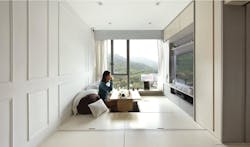Homebuyer Demographics: Are You Ready for This?
As we say goodbye to a decade and enter a new one, the world continues to evolve in a multitude of ways that affect consumers, homes, and communities. In the year and decade ahead, we will see disruptions in how we live, the way homes are designed and built, as well as the reinterpretation of what community means.
These changes will be the result of a shifting economic, work, and lifestyle scenario that is enhanced by new technologies. To quote philosopher Alan Watts, “The only way to make sense out of change is to plunge into it, move with it, and join the dance.” The question is not whether our environments are transforming, but rather, whether we have the agility in planning to anticipate and react to those changes.
6 Unique Generations Influencing the Housing Market
Evolution starts with the consumer, and we’re entering a time in which there are six unique and influential generations in the market, presenting both a challenge and an opportunity for housing:
- Global-From-Birth
- Generation Z
- Millennial
- Generation X
- Baby Boomer
- Prime Timer
RELATED
Here's a look at each generation, exploring their key characteristics.
1] The Global-From-Birth Generation
Let’s start by understanding the youngest generation, which we call Global-From-Birth (ages 0-11 in 2020). Members of this 40-million-strong cohort are the offspring of Millennials (ages 24-44 in 2020), a generation (our largest ever at 87 million) of which at least half are now becoming parents, with 1 million giving birth each year.
The reason we say this youngest generation has influence on the home is that Millennials will have a particularly close relationship with their kids. This dynamic means bringing play directly into a living space.
A great example of this is the work HAO Design, in Taiwan, is doing in home design for new builds and remodels. Its Family Playground concept eschews traditional floor planning in favor of one “crafted to meet the specific needs of those who live in the residence,” highlighted by chalkboard surfaces on cabinet and appliance fronts; a versatile, multiuse “kids’ nook” (including an indoor slide) within the family gathering area; and minimal bedrooms dedicated more for sleeping than individual interests (see below).
We also see the return of the basement play area, game and music rooms, and outdoor spaces—all ways for today’s parents to offset the increasing influence of technology with analog play.
2] Generation Z
The newest homeowner generation, Gen Z (ages 12-23 in 2020), has a lot in common with the World War II generation of Prime Timers (ages 76+ in 2020) in terms of being practical and pragmatic. At 52 million strong, Gen Z is a hopeful, activist generation and, like the Greatest Generation, will insist on changes that make the world a better place.
The way Gen Z lives will be much more diversified, starting off in their parents’ homes as young adults, then maybe moving to a co-living space, then an apartment for three to six years, perhaps a tiny house as a first purchase, and then a more traditional home. In other words, a far different arc from that followed by older generations pursuing the American Dream.
We’re entering a time in which there are six unique and influential generations in the market, presenting a challenge and opportunity for housing.
Consider the options this generation has for living space that are totally new to the 21st century: Airbnb, rent-to-own, home sharing, co-living, hospitality apartments, and more. This diversification will continue, presenting challenges for traditional builders while bringing fresh inspiration for remodelers in making small spaces live larger.
With that, Gen Zers will be looking for communities that include areas to grow food and provide varied exercise options, opportunities to connect with neighbors, and sharing facilities, such as a neighborhood tool truck and electric bikes. ReGen Villages in the Netherlands, where every home has its own attached greenhouse, is a great example for future developments serving Gen Z.
3] Millennials
Millennials have already made a mark on the housing industry, bringing open space concepts, seamless indoor/outdoor living, kitchens that multitask, and dual-working spaces for the rising freelance/side-hustle economy. They’ve made high-density housing, such as row houses and duplexes, popular again.
This design-savvy generation, which places a premium on good design, isn’t afraid to break with existing norms. Our company has reported on trends in regional architecture and interior design for two-plus decades, and with 40% of Millennials now homeowners, we see faster and more innovative change.
This trend is due to this generation’s demand for sensory design (think: sight, touch, sound) and incorporating technology into their environment, as well as the amazing advances we’ve seen in material excitement with more eco-friendly, predictive (smart), and flexible products.
A static home is a thing of the past. As such, the future Millennial home will be smart (tech), savvy (design), sensory (materials), safe (wellness and security), and shape-shifting (able to change spaces as lifestyles evolve), as exemplified by the designs of Sim-Plex Design Studio, in Hong Kong, among others, featuring movable architecture. And Millennials will be drawn to mixed-use communities that include retail, hospitality, health care, and flexible workplaces.
4] Generation X
Gen X (ages 45-54 in 2020) tends to receive less attention due to its comparatively smaller numbers (41 million), but this generation has entered its prime earning years and is overtaking Baby Boomers in dollars spent on home remodeling. Gen X also comprised the second-largest segment of homebuyers in 2018 at 24%, according to the National Association of Realtors’ 2019 Home Buyer and Seller Generational Trends report, and with younger adult children and aging parents, is the generation most likely to need and buy multigenerational homes.
For Generation X, home is less about flipping or moving up and more about staying and remodeling. In middle age, they have brought practicality into home environments: hallways that work for storage and auxiliary living space, smaller secondary bedrooms to allow for more bathrooms, spaces for pet needs, and active use of outdoor living environments.
Gen X also is about “benefit-driven” purchases and sustainability, being the first generation to bring the rising need for eco-friendly strategies to the forefront in building and remodeling.
5] Baby Boomers
Can you believe that the oldest of the 82 million Baby Boomers are in their 70s? This generation (ages 55-75 in 2020) has entered a new life stage we call Adulthood II. This “second act” has them working longer, continuing to be very socially and physically active, and monetarily helping their kids with homebuying and child care.
According to a 2019 Chase survey, nearly nine in 10 Boomers are looking to make home improvements, as the majority of the generation focus on upgrades rather than downsizing or moving. However, as this cohort ages, we are seeing a shift to more Boomers (25% to 35%, according to various surveys) seeking a new home and community.
Understanding that one in eight Baby Boomers will live to be 100, the need for aging-in-place amenities will be the largest rising segment of home improvement in the years to come. However, Boomers’ forever-young mentality will require a level of remodeling ingenuity not seen in the past: no ugly grab bars for this generation, but rather a beautiful blueprint that incorporates universal design principles to enable true lifestyle conveniences; a home or remodel that goes beyond wider entryways and no-threshold showers to incorporate smart technology, wellness materials and products, lighting innovations, and creative layout strategies.
6] The Prime-Timer Generation
When we think about Prime Timers (ages 76+ in 2020), it should be simultaneous with attention to the aging Baby Boomer cohort. Due to Boomers’ large population size and increasing life expectancy, the number of Americans age 65 and older is projected to nearly double from 52 million in 2018 to 95 million by 2060, and the 65-and-older age group’s share of the total population will rise from 16% to 23%.
Now is the time when builders and policymakers must think seriously about what will be needed to house these generations. We’re already seeing local state laws change to allow backyard accessory dwelling units (aka granny flats) as affordability for many Baby Boomers will be an issue as they live longer.
There are key macro drivers that will affect building and remodeling across all age groups, and these include bringing prefab into the construction process for efficiency, personalization, and cost-savings; net-zero energy and sustainability enhancements; wellness strategies that include new materials, nature (courtyards are coming back), and grow-your-own food (kitchen appliances); technology (predictive and proactive smart tech); and safety concerns due to climatic issues.
Consumers’ fear factor regarding wildfires, floods, high winds, and extreme heat are prompting new developments in how we build the protective home. And, perhaps most important, the home of the 2020s will be one that can live longer, with the ability to personalize and shift spaces as lifestyle changes dictate.
One thing we know for sure: This next decade of the 21st century will bring more advancements to our most important asset, the home.
Susan Yashinsky is VP innovation predictor at Sphere Trending, in Waterford, Mich., providing trend insights and strategies for home environments, automotive, retail, commercial environments and services, and technology industries and businesses.
Access a PDF of this article in Pro Builder's January 2020 digital edition












